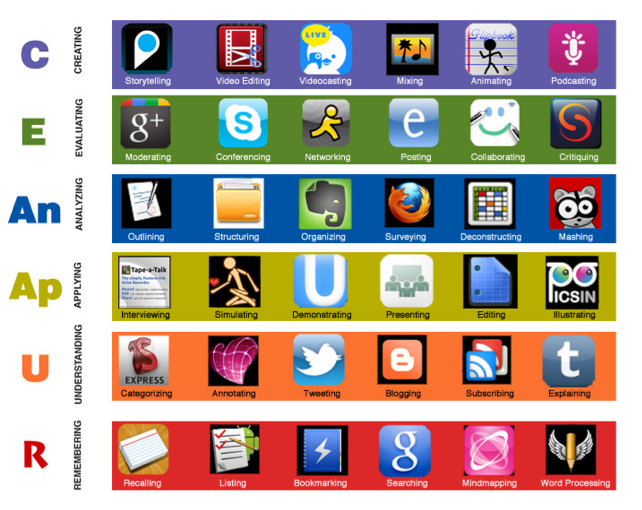I created two projects demonstrating the use of Web 2.0 tools in the classroom. First, I collaborated with a small group to create a Google Presentation and shared one of my favorite tools, Evernote.
Next I outlined the implementation of an activity in my classroom using Web 2.0 tools. In the development, I thought about what the experience looks like for students, the types of outcomes they might have, and the kinds of directions I might provide in order to assure their success. I also considered the response that students might have to the use of such tools, as well as the barriers you might face. Finally, I aligned the activity to a learning objective, and used verbs from the top three levels of Bloom's Taxonomy.
I
anticipate that students will enjoy working on this project. The
flexibility to produce their own media offers the opportunity to take
photos and video, an activity most students enjoy. Most students also
enjoy creating and viewing each other’s video products.
Working in a group offers students to chance to self-select to contribute more heavily in areas that draw on their personal interests and skill sets. It also give students peer support in learning new skills.
Standards
3.1 Distinguish among rectangles, parallelograms, and trapezoids.
Standard for Mathematical Practice
Construct viable arguments and critique the reasoning of others.
ISTE NETS
1. Creativity and Innovation
Students demonstrate creative thinking, construct knowledge, and develop innovative products and processes using technology.
2. Communication and Collaboration
Students use digital media and environments to communicate and work collaboratively, including at a distance, to support individual learning and contribute to the learning of others.
3. Research and Information Fluency
Students apply digital tools to gather, evaluate, and use information.
Locate, organize, analyze, evaluate, synthesize, and ethically use information from a variety of sources and media.
 Bloom’s Digital Taxonomy Correlation
Bloom’s Digital Taxonomy Correlation
- Evernote: Analyzing
- Animoto: Creating
- Collaborating: Evaluating
- Googling: Remembering
- Editing and Presenting: Applying
Implementation
Students work in a collaborative group to:
Create and publish video that shows examples of rectangles, parallelograms, and trapezoids in the real world.
- Use copyright cleared images/video or take photographs/record video
- Collect and collaborate using web-based tools
Differentiation
Scaffold
students’ learning curve by teaching front-loading technical skills
prior to assigning this project. Create web-based help resources for
students to access during their project’s creation. (See example
in this link.)
![]() Evernote: Post a link to Evernote notebooks on my class website. Students
would have experience accessing resources from the notebooks as far in
advance of the assignment of this project as possible. Prior to setting
up their own accounts for a project, students would have experience
accessing a shared notebook. Prior to the project beginning, I would
teach the creation of a user account and notebook creation, tagging, and
sharing.
Evernote: Post a link to Evernote notebooks on my class website. Students
would have experience accessing resources from the notebooks as far in
advance of the assignment of this project as possible. Prior to setting
up their own accounts for a project, students would have experience
accessing a shared notebook. Prior to the project beginning, I would
teach the creation of a user account and notebook creation, tagging, and
sharing.![]() Animoto:
At the beginning of the year, I’d play, then post to my class website, a
video I created to introduce myself using the tool. Students would
then create a video to introduce themselves, focusing on whatever aspect
of their personality they would like to showcase. Videos could be
shared on a secure location for students to view once signed Media
Permission forms are received from parents.
Animoto:
At the beginning of the year, I’d play, then post to my class website, a
video I created to introduce myself using the tool. Students would
then create a video to introduce themselves, focusing on whatever aspect
of their personality they would like to showcase. Videos could be
shared on a secure location for students to view once signed Media
Permission forms are received from parents.
Rubic
I would create a two separate rubrics, one for the collaboration and one for the video. The rubric would be created using
Rubistar.
Barriers
- Working Collaboratively - Students may resist working in groups or working with partners they do not choose.
- Technology Frustration - Students may have a low threshold of frustration when working with technology.
- Content Area Issues - Students may need extra support to identify appropriate media for the assignment.